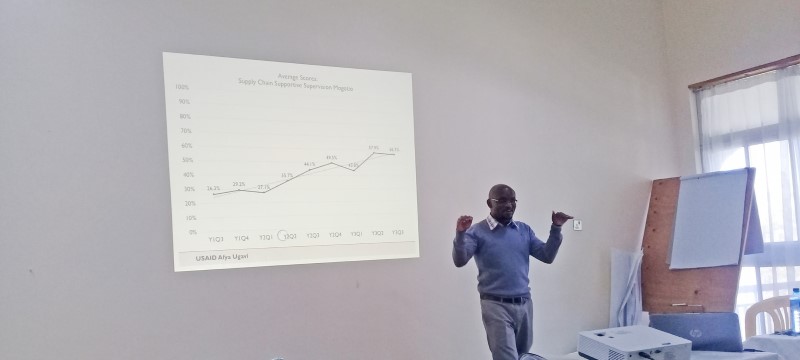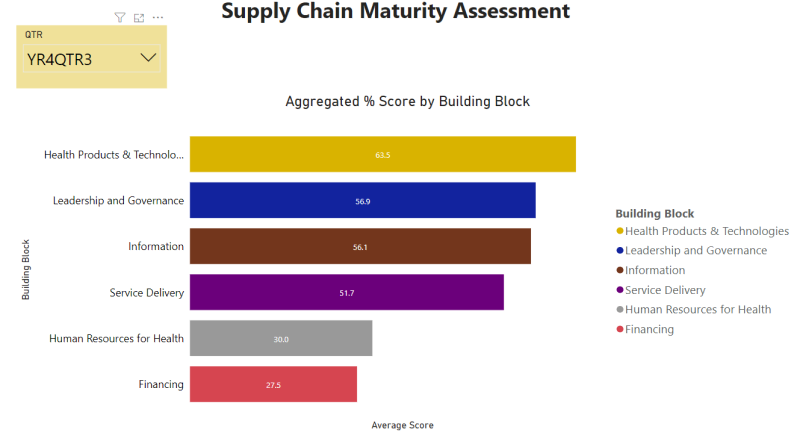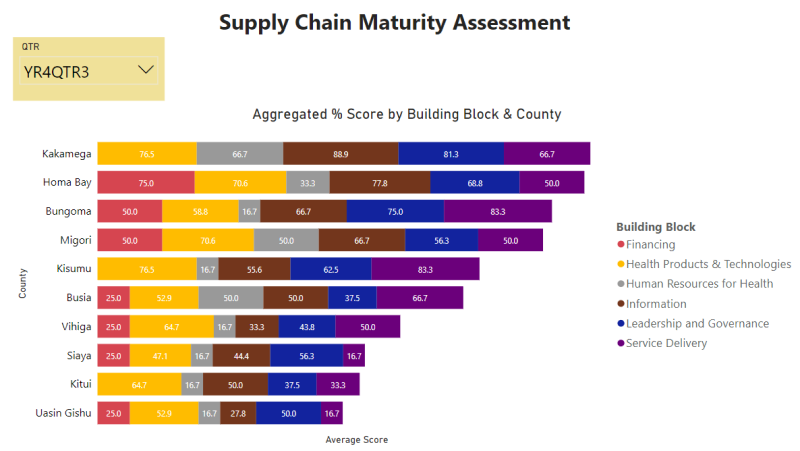Afya Ugavi Activity has developed the Supply Chain Maturity Assessment Tool (SMAT), an innovative approach towards enhancing county supply chain performance for sustainability and working with the counties to track their own Journey to Self-Reliance. The SMAT tool measures the maturity level of a country’s supply chain through a series of respective focus questions that are assessed after every three months and the scores summed up to generate an overall performance score. It is anchored on the six building blocks of World Health Organization (WHO)’s health systems strengthening approach as they apply to supply chain management. These are: leadership and governance, health products and medical technologies, service delivery, information, finance, and human resources for health (HRH).

The United States Agency for International Development (USAID) is reorienting its strategies, partnership models, and program practices to achieve greater development outcomes and work toward a time when foreign assistance is no longer necessary. It’s called the Journey to Self-Reliance. This means working to achieve locally sustained results, helping countries mobilize public and private revenues, strengthening local capacities, and accelerating enterprise-driven development. USAID’s Afya Ugavi Activity is leading journey to self-reliance in supply chain management in Kenya’s 10 counties, and constantly asking the questions highlighted above.
“How will we know that the counties have capability to sustainably manage optimally functioning health supply chain system? When can we say with certainty that counties are ready, or not?” - USAID’s Afya Ugavi Activity
The tool is tailored to Kenyan context and enables progressive measurement of the supply chain maturity for the two levels of Government. The County staff self-administers the SMAT tool to the Health Products and Technology Units to rank and assess readiness for transition. When a county attains 80 percent across the Heath Systems Strengthening pillars, it is deemed mature, and self-reliant. In areas of weakness, the county is supported and mentored to develop action plans, and sustainably address emerging issues.
Following rounds of assessments using the SMAT tool, Afya Ugavi has supported the 10 counties (Kakamega, Homa Bay, Migori, Uasin Gishu, Vihiga, Bungoma, Kitui, Kisumu, Busia and Siaya) to progressively strengthen weak areas for an overall improvement in supply chain performance. The SMAT tool has enabled counties to identify gaps in supply chain performance, and develop interventions and actions needed to make bold improvements.

Despite the COVID-19 challenges, all counties have registered improvement in their overall scores, demonstrating progressive action towards supply chain maturity. Over the assessments undertaken in two quarters, Kakamega moved from a score of 56.7% to 74.6%, Kisumu from a score of 38.8% to 58.2, Migori from 53.7% to 61.2%, Uasin Gishu from 28.4% to 37.3 %, and Kitui from a score of 13.4% to 43.3%. Further action in the coming months should progressively work towards tackling supply chain maturity components and assist the counties to move towards attaining a sustainable level of supply chain maturity.
Against an aggregated score, the above graph gives an analysis of the average performance score for all the counties across the building blocks.
While county performance was progressive in the health products and technologies, the assessment revealed weakness in the human resources and finance areas. This means a need for enhanced advocacy at the counties for increased funding as determined during forecasting and supply planning for essential medicines and medical supplies (EMMS). These include program commodities, capacity (skills and funds), procurement, and county fully funded budget for EMMS and supply chain systems.

A comparison of counties’ performance across the building blocks is helping to assess best practices, and gaps that can help inform interventions and adaptive cross-learning.
In Finance, Homa Bay had the better performance with a score of 75%. The area of weakness for Homa Bay remains lack of a fully funded supply chain systems strengthening budget (40%). In health products and technologies, Kakamega County scored highest, but also with a zero score in finance. Kakamega County led in human resources for health (66.7%), information (88.9%), and leadership and governance (81.3%), while Bungoma County topped service delivery (88.3%).
The goal is to attain 90% score in each of the parameters. Afya Ugavi provides targeted support that sustains stronger areas while strengthening through capacity development, areas that are weak. Key activities relevant for each pillar are progressively addressed. For example, designated supply chain personnel are all trained in commodity management and staff numbers aligned to HRH norms and standards for supply chain. In information, it is expected that at least 80% of all hospitals implement electronic dispensing tool that generate monthly reports.
At national level, USAID’s Afya Ugavi Activity is supporting development of the first national supply chain strategy to provide a roadmap for stronger supply chain management in Kenya. At the county level, it is championing establishment of health products and technologies units as pivot entities for supply chain management institutionalization.
“The SMAT tool has provided us with evidence on our progress and areas of that require improvement. It has enabled the county leadership to be intentional about strengthening supply chain system across the pipeline for improved service delivery.” - Dr. Beatrice Muia, County Pharmacist, Kitui County.


